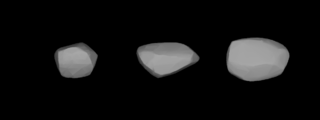Related Research Articles

99 Dike is a quite large and dark main-belt asteroid. Dike was discovered by Alphonse Borrelly on May 28, 1868. It was his first asteroid discovery. This object is named after Dike, the Greek goddess of moral justice. Among the first hundred numbered minor planets, 99 Dike was considered anomalously faint for over a century. However, this was later found to be untrue.

140 Siwa is a large and dark main-belt asteroid that was discovered by Austrian astronomer Johann Palisa on October 13, 1874, and named after Živa (Šiwa), a Slavic goddess of fertility.

149 Medusa is a bright-coloured, stony main-belt asteroid that was discovered by French astronomer J. Perrotin on September 21, 1875, and named after the Gorgon Medusa, a snake-haired monster in Greek mythology. It is orbiting the Sun at a distance of 2.17 AU with a period of 3.21 years and an eccentricity of 0.065. The orbital plane is tilted slightly at an angle of 0.94° to the plane of the ecliptic.

186 Celuta is a 50 km Main belt asteroid. It was discovered by the French astronomers Paul Henry and Prosper Henry on April 6, 1878. This was the last discovery credited to the Prosper brothers. It is classified as an S-type asteroid.

202 Chryseïs is a large, lightly coloured Main belt asteroid that is probably composed of silicate rocks. It was discovered by C. H. F. Peters on September 11, 1879, in Clinton, New York, and was named after the mythical Trojan woman Chryseis.

224 Oceana is an asteroid from the asteroid belt. It was discovered by Austrian astronomer Johann Palisa on 30 March 1882, in Vienna. It was named after the Pacific Ocean. Based upon its spectrum, it is classified as an M-type asteroid, but is not metallic.
256 Walpurga is a large Main belt asteroid. It was discovered by Johann Palisa on 3 April 1886 in Vienna and was named after Saint Walburga.

309 Fraternitas is a typical Main belt asteroid. It was discovered by Johann Palisa on 6 April 1891 in Vienna. The asteroid name is Latin for 'fraternity'; it was so named in order to commemorate the 25th anniversary of the Maturitätsprüfung Fraternity.
475 Ocllo is a large Mars-crossing asteroid. It was discovered by American astronomer DeLisle Stewart on August 14, 1901 and was assigned a provisional name of 1901 HN.
535 Montague is a minor planet orbiting the Sun that was discovered by Raymond Smith Dugan on 7 May 1904 in Heidelberg, Germany. It was named after the town Montague in Massachusetts.
568 Cheruskia is a minor planet, specifically an asteroid orbiting in the asteroid belt that was discovered by German astronomer Paul Götz on 26 July 1905 from Heidelberg.

573 Recha is a minor planet, specifically an asteroid orbiting in the asteroid belt between Mars and Jupiter. The asteroid, discovered by German astronomer Max Wolf on September 19, 1905, was named after a character in Gotthold Ephraim Lessing's play Nathan the Wise and may have been inspired by the asteroid's provisional designation 1905 RC.
575 Renate is a minor planet, specifically an asteroid orbiting in the asteroid belt which was discovered by German astronomer Max Wolf on September 19, 1905. The name may have been inspired by the asteroid's provisional designation 1905 RE.

572 Rebekka is a minor planet orbiting the Sun, which was discovered on September 19, 1905, by a German astronomer Paul Götz in Heidelberg. It was named after a young lady from Heidelberg, and may have been inspired by the asteroid's provisional designation 1905 RB.
585 Bilkis is a minor planet, specifically an asteroid orbiting in the asteroid belt. It was discovered by German astronomer August Kopff in 1906 February and was given the Koran name for the Queen of Sheba. Photometric observations at the Palmer Divide Observatory in Colorado Springs, Colorado in 2006–7 were used to build a light curve for this object. The asteroid displayed a rotation period of 8.5742 ± 0.0005 hours and a brightness variation of 0.40 ± 0.02 in magnitude.
603 Timandra is a minor planet orbiting the Sun that was discovered by American astronomer Joel Hastings Metcalf on February 16, 1906, in Taunton, Massachusetts.

605 Juvisia is a minor planet, specifically an asteroid orbiting in the asteroid belt that was discovered 27 August 1906 in Heidelberg by German astronomer Max Wolf. It was named after the commune Juvisy-sur-Orge, France, where French astronomer Camille Flammarion had his observatory.
620 Drakonia is a minor planet, specifically an asteroid orbiting in the asteroid belt. It was discovered October 26, 1906, in Taunton, Massachusetts, by American astronomer Joel Hastings Metcalf and given the preliminary designation 1906 WE. It may have been named for Drake University.

673 Edda is a minor planet orbiting the Sun. It was discovered 20 September 1908 by the American astronomer Joel Hastings Metcalf, and was named for the Norse Edda literary works. The name may also have been inspired by the asteroid's provisional designation 1908 EA. This asteroid is orbiting at a distance of 2.81 AU with a period of 4.72 yr and an eccentricity of 0.012. The orbit is close to a 5:2 mean motion resonance with Jupiter, which is located at 2.824 AU.
687 Tinette is a minor planet, specifically an asteroid orbiting primarily in the asteroid belt. It was discovered by Austrian astronomer Johann Palisa on 16 August 1909 from Vienna and was given the preliminary designation 1909 HG.
References
- 1 2 Yeomans, Donald K., "574 Reginhild", JPL Small-Body Database Browser, NASA Jet Propulsion Laboratory , retrieved 5 May 2016.
- 1 2 Pilcher, Frederick (April 2011), "Rotation Period Determinations for 25 Phocaea, 140 Siwa, 149 Medusa 186 Celuta, 475 Ocllo, 574 Reginhild, and 603 Timandra", The Minor Planet Bulletin, vol. 38, no. 2, pp. 76–78, Bibcode:2011MPBu...38...76P.